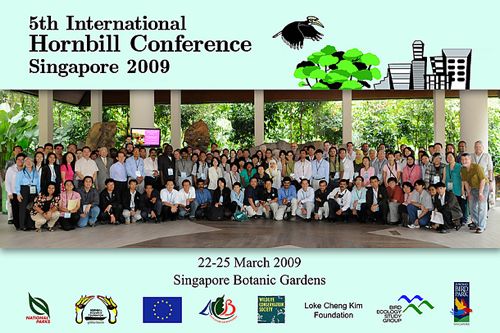
Co-hosted by Singapore’s National Parks Board and Thailand’s Hornbill Research Foundation, the 5th International Hornbill Conference ran from 22nd to 25th March 2009.
The conference brought together such hornbill luminaries like Alan and Meg Kemp, Pilai Poonswad, Margaret F Kinnaird, Timothy G. O’Brien and a host of hornbill researchers from around the world.
More than 50 papers and posters were presented in addition to three keynote papers. The subjects include the status and distribution of hornbills, their ranging behaviour, research techniques, conservation aspects, threats to their existence and feeding as well as breeding behaviour. In addition, the team from the Singapore Hornbill Project, led by Marc Cremades, presented their findings after more than two years of meticulous research on the local Oriental Pied Hornbills (Anthracoceros albirostris) in the offshore island of Pulau Uban and the Jurong BirdPark. In particular, their presentation on the high-tech nesting box, where monitoring can be made 24 hours a day, got the total attention of participants.
This conference covers the research undertaken on hornbills from around Asia and Africa since the last conference five years ago.
The Bird Ecology Study Group is proud to be associated with this international hornbill conference.
YC Wee
Singapore
March 2009
(Image by Jac Lau)









8 Responses
Dear Sirs,
I was taking a stroll at Ang Mo Koi Hill Park around 12.30 pm this afterternoon with my wife. I spotted a pair of Oriental Pied Hornbills flying from tree to tree.
It was a very pleasant surprise to see hornbills in Ang Mo Kio, better still if hornbills will eventually nest in AMK Hill Park.
I hope that National Parks Board will allow all the large trees and thick shrubs in AMK Hill Park to grow and attract even more bird life.
Best regards
Paul Chu
27Mar09.
There are plans to place artificial nesting boxes in various locations around Singapore. This will invariably increase the population of hornbills.
I’m delighted to inform you that we have a pair of Oriental Pied Hornbills happily nesting in Ridout Road in the very heart of Singapore. It gives us untold please to see them sharing and caring for each other everyday. And the more trees in Singapore the more it will become a tropical haven for the extraordinary birdlife only SE Asia can provide.
Yours sincerely
Justin White
OPH is slowly but surely spreading throughout Singapore. However, they need old trees with natural cavities to nest and these are in short supply. Happily, there is a move to set up nesting boxes at selected locations…
Hey, Justin — can’t believe we met and were talking about this on Friday, and today I just happened to see you have posted your sightings to BESG. Let’s hope the nesting is successful